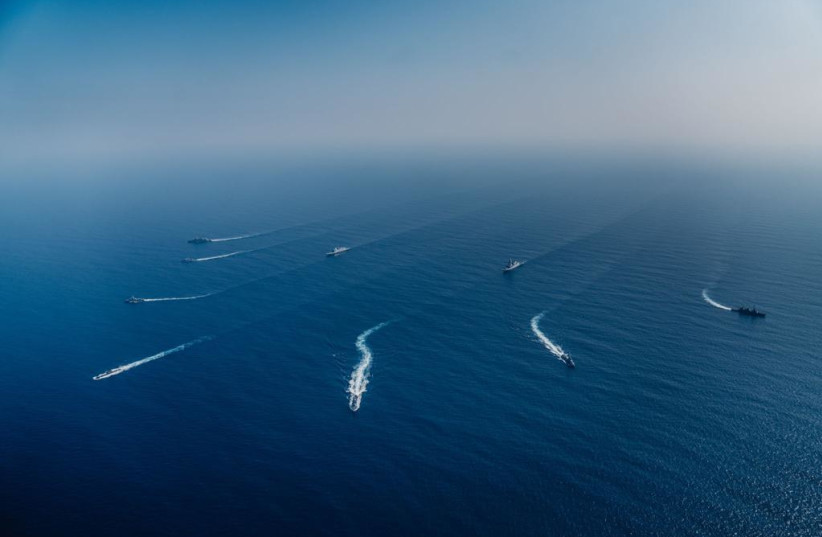The Israel Navy and five other countries completed an international joint drill this week, Naval Squadron 32 Cmdr. Steven Gordon told The Jerusalem Post.
“We led this international drill for three weeks, including Greece, Cyprus, Italy, the US and France,” he said. “This was one of the bigger drills. We went all over the Mediterranean Sea and along the various coast points of Israel.”
The exercise involved a mix of surface vessels, submarines and aircraft, Gordon said.
The drill was historic because it was the first time that the relatively new Sa’ar 6 vessel participated in an international drill, even though it has participated in internal Israeli drills since being delivered to Israel more than two years ago, he said.
Various other Israeli naval vessels, including the Sa’ar 5, were also involved, he added.

What is the Sa'ar 6 ship?
The Sa’ar 6 is 90 meters long, weighs 2,000 tons and has a maximum speed of 24 knots, with a range of 2,500 nautical miles. Even though the Sa’ar 6 is not much longer than the Sa’ar 5, it has been built to better handle rough seas and stay at sea longer.
“The drill included practicing maneuvers and operations against submarines, other above-surface vessels, aircraft, maneuvers to protect strategic assets and inspections of suspicious ships,” Gordon said.
The reference to suspicious ships would usually refer to efforts to smuggle weapons or carry out operations by terrorist groups from the Gaza Strip, but it could also relate to Iranian smuggling attempts throughout the region.
Gordon did not want to reveal specific scenarios, but it appeared that the reference to strategic assets included defending Israel’s natural-gas platforms.
He cited a July 2022 incident in which the IDF shot down three unmanned aerial vehicles launched by Hezbollah toward Israel’s economic waters over the Mediterranean Sea.
One of the three UAVs was shot down by an F-16, but two others were downed by the naval Barak 8 medium-range, surface-to-air, missile-defense system, which is also installed on the Sa’ar 6, marking the first time the system was used against aerial threats.
The Barak-8 MR-SAM system is able to shoot down enemy aircraft at a range of 50-70 kilometers (32-43 miles). It is designed to defend naval vessels against a myriad of short- to long-range airborne threats, such as incoming missiles, planes and drones at low or high altitudes.
Gordon confirmed that his naval vessels trained “to defend against drone attacks.” The Barak 8 missile-defense system is only one of various options against drones, he added.
The Sa’ar 6 is also equipped with two Naval Dome missile interceptors for rockets – the maritime version of the land-based Iron Dome. In addition to interception missile-defense systems, the ships also have 16 anti-ship missiles, one 76-mm. Oto Melara Super Rapid main gun, two Typhoon 25-mm. remote weapon stations and two 324-mm. torpedo launchers for MK54 Lightweight Torpedoes. Each state-of-the-art ship will also be outfitted with cyber- and electronic-warfare systems.
Asked whether some of the threat scenarios the forces trained for parallel threats from Iran to use naval vessels to transport weapons to Syria and Lebanon, Gordon said the exercise addressed every threat the Israel Navy might face. “Anything you can imagine, we drilled for it,” he added.
Including the Sa’ar 6 in the exercise was both significant to practice using some of its new capabilities and for seeing how it performed when needing to operate in conjunction with international forces, Gordon said. “It is part of our central forces for the Mediterranean Sea,” he added.
Gordon discussed how training with foreign naval forces enhances readiness and opportunities to learn from each other and share strategy and tactics.
The foreign navies were very interested in Israeli capabilities, he said, and “There is also an opportunity to build diplomatic and professional relationships.”
Moreover, Gordon explained how the different countries sent officers onto each other’s naval vessels to observe the operations and to better facilitate developing joint points of reference and sharing tactics.
“The drill was very successful, and all of the other forces were very happy,” he said. “We can defend against any threat.”
